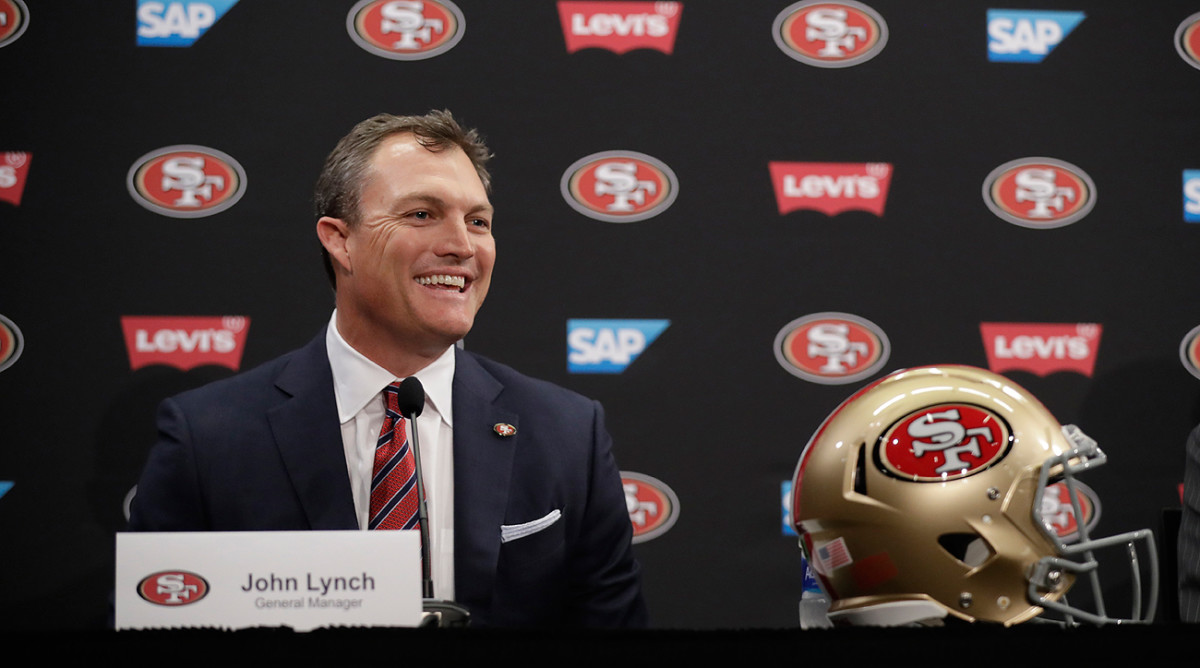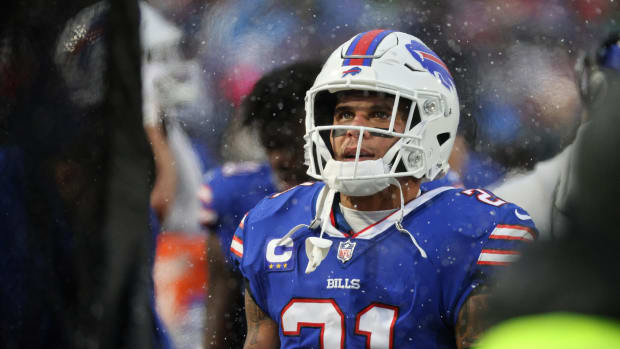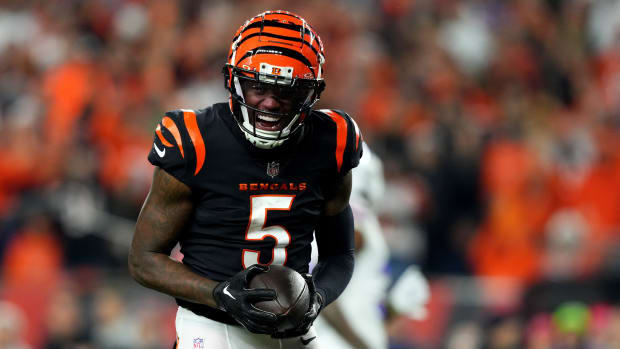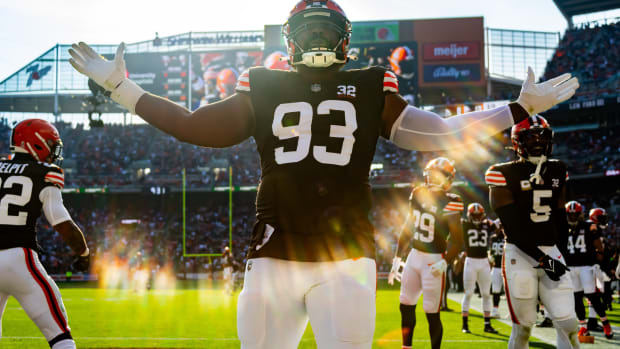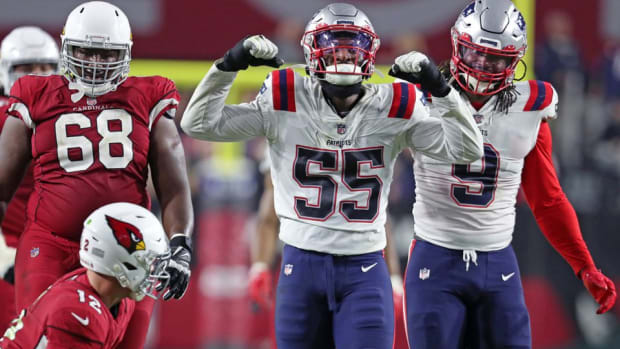The Unconventional Career Path of 49ers GM John Lynch
Behind John Lynch’s desk in Santa Clara, there are a number of bottles of wine, each one wishing him luck in his new venture as the 49ers general manager. That he got them from agents is one surprise from his first three weeks on the job.
“I’m telling you, I didn’t think agents were this nice,” he said over the phone on Wednesday afternoon, laughing before conceding, “They’re buttering me up.”
The haul of reds hasn’t been the only things to catch Lynch a little off guard with this move that set the football world back on its heels at the outset of Super Bowl week. There’s the breadth of the work, which goes well beyond scouting. And related to that, there’s how a GM gets pulled in so many different directions during a given day.
But there’s good news here, too. With a couple weeks to spare before the Niners staff packs up for Indianapolis and the scouting combine, this very much feels to Lynch—the former player and broadcaster—like what he’s supposed to being doing.
“It does,” he said. “I’d caution you, one thing Monte Kiffin always said to us was that the worst three words any football player can say are, ‘I got it.’ I’m right at the beginning stages. We’re right at the beginning stages. We’re taking on challenges every day. But I can tell you, I’m not overwhelmed, each day I come in and there’s a routine.
“A priest once said to me, ‘Think about eating a huge steak, you can’t eat it all in one bite. You gotta take one bite at a time.’ And that’s the way we’re going through it. You can get overwhelmed in this job, particularly coming in late. I got all this to do, how do I do it? Instead, we’re just going about our business each day and taking things as they come. It does feel very natural.”
In this week’s Game Plan, we’ll look at how the 2018 quarterback crop could affect the Mitch Trubiskys and Deshaun Watsons of this year, the Redskins’ Kirk Cousins quandary, how the use of the franchise tag has changed dramatically over the past five years and a lot more.
But we start with the Niners’ new GM, his first few weeks on the job, and why he hardly feels like a fish out of water—despite the fact that he landed in his new role without taking the traditional path to it.
Lynch’s precursor to one of 32 jobs running the personnel side of an NFL franchise is comprised of 16 years as a player and some eight-and-a-half seasons working his way up in the world of football broadcasting. He, in fact, never left pro football, having been involved for the past 24 years running. And this is where, in these stories about him, you point out where he was never a scout.
That’s where we’ll take our left-hand turn. Let’s explain why, through his words, his start has proven Lynch to be more prepared than most of the skeptics expected, and how he already has a pretty evolved vision.
• His playing experience. That’s beyond just having played for Denny Green, Bill Walsh, Sam Wyche, Tony Dungy, Jon Gruden, Mike Shanahan and, briefly, Bill Belichick. It also goes past figuring, between the lines and through endless film study, what makes a great NFL player. And it goes to his first experience in the pros, and being part of the 1990s Bucs’ transition from doormat to dominant force.
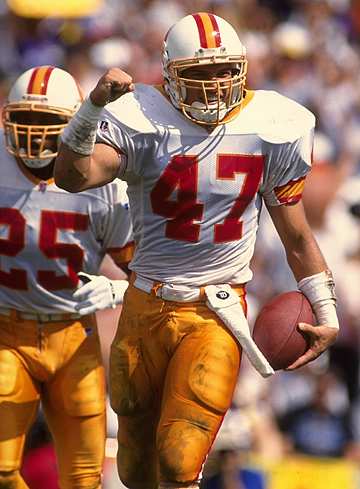
In Tampa Bay for 11 seasons (1993-2003), John Lynch got a first-hand look at how a franchise can turn itself around.
Scott Halleran/Getty Images
“There’s a lot of parallels,” he says, comparing those Bucs with these 49ers. “There’d been constant change, so the thought process as a rookie was ‘don’t get close to the guy next to you, because he may not be here in a couple weeks. Don’t let your wives make friends, because they’re not gonna be here.’ That was the culture. Everybody talks about Tony [Dungy], and Tony was certainly integral.
“But before that, Rich McKay came in and brought some stability—we’re gonna draft good winning players that have certain traits, and football character. Then Tony came in and gave it more stability—these are the schemes we’re gonna play. We’re not deviating in Week 1 or Week 2 if it’s not working. We’re sticking to them.”
• His TV experience. Lynch settled in Denver after his playing career and grew close to John Elway. So when Elway took the Broncos’ job in 2011, he’d get after Lynch about leaving broadcasting to work for a team. To that end, in 2012, Elway had him write reports on safeties in the draft. In 2013, Lynch sat in Denver’s draft meetings for a month.
Now, Lynch maintains that he followed advice he got from Mike Tomlin in Tampa: Be where you’re at. He was focused on his job with Fox, and was moving up in the ranks there. Still, he knew, as he puts it, “What was missing was a scoreboard.” And so Elway’s poking, plus working to be prepared as a broadcaster, opened the door to Lynch subconsciously developing team-building beliefs in the course of his work.
“I wasn’t out there soaking up information from organizations as I went in their buildings, I was trying to be the best broadcaster I could be,” he explains. “But you’re meeting with the quarterback, you’re meeting with the head coach, the GM usually comes and finds you, you’re meeting with coordinators on both sides, you’re meeting with finest players in the league. … So it challenges your mind.”
• His Broncos experience. At one point, Elway discussed hiring Lynch before deciding he didn’t have the right role for him. In the end, the Broncos GM may have given him something more valuable than a job—an open-door to his own experiences growing into the role without the traditional career path behind him.
Two pieces of advice stuck with Lynch. First, Elway said “hire some good people around you,” which Lynch now jokes was to Elway’s detriment, since Lynch’s first hire was one of Elway’s best people—new 49ers VP of player personnel Adam Peters. Second, Elway told Lynch that he had to learn to close his door, which seems simple, but relates to time management as a boss.

A close relationship with John Elway helped prepare Lynch for his new GM role.
Cyrus McCrimmon/The Denver Post via Getty Images
“Day 1, all I wanted to do was turn on the tape of the San Francisco 49ers to see what we have,” Lynch says. “And it wasn’t until 4:30 that I finally turned the tape on, because I was meeting people, meeting the trainer, going through the office. But that was very important too. That’s how it is. … You also have to learn to close your door. You need your quiet time to yourself where you can just get stuff done.”
• His life experience. Lynch says that, at the end of his playing career, “You’re always saying, ‘I haven’t come close to knowing it all, there’s always something I can improve on.’” He took that thirst to learn into broadcasting, and he plans to take that humility into his new job, too. “I think that’ll be the case 15 years from now,” he says.
Early on, it’s been small stuff. At the Super Bowl, both college and NFL players would approach him, and he’d wonder, Is this tampering? He’s leaned on Peters and fellow new hire, and former Lions GM Martin Mayhew, for help in those areas. And he knows he has a lot to learn elsewhere. So yes, he’ll delegate some. But what’s as important is that he maintains that quest for knowledge in all areas.
“Part of the interview process was, 10 characteristics of a GM, go 1-10 on what you’d be strongest at,” he says. “And I just followed my heart. Setting the tone and vision for a building, that was 1. Negotiating salary cap and contracts, right off the bat, I had that as 10, because I haven’t done it. So listen, I’m gonna have to rely on some people. But I will learn that, because I think to be good at it, you can’t just say, ‘that’s my guy over there.’ You gotta learn it and be a part of it.”
So why will this work? I don’t know if it will, because these are hard things to forecast. But I do think that Lynch and head coach Kyle Shanahan have a chance, and not just because both are competitive, smart and driven football junkies. My feeling is it’s more because Shanahan has a very defined vision for a football team, and Lynch has a clear-headed idea of how to build that, and they share a lot of ideals.
Getting that alignment was a stated goal of CEO Jed York’s during the GM/coach search, and it looks like San Francisco has that at this early juncture. On Tuesday, Shanahan gave a lengthy, detailed presentation for the scouts on what his staff would be looking for at each position. And that adds detail to the character traits Lynch has talked to his scouts about seeking.
One that Lynch calls “critical” is football character. “You gotta live it and breathe it,” he says.
The 49ers GM certainly does, and he’s gotten to work in surrounding himself with others that do, too. Which is probably why none of this feels unnatural to him at all.
* * *
FIRST AND 10
1. I’m told Rams quarterback Jared Goff has hired and is already working with renowned coaches Adam Dedeaux and Tom House. Good sign, regarding Goff’s commitment.
2. Let’s be honest about why the NFL doesn’t want Joe Mixon et al in Indy: The combine is a TV show, and the league doesn’t want it to be about Mixon.
3. It’s a tough blow for teams. The combine is the best place to get an apples-to-apples look at prospects’ problems, whether it’s an injury or character issue.
4. Anthony Lynn’s proclamation that he’s not a players’ coach can be verified. As to his mentors, the Chargers coach identifies most closely with Bill Parcells.
5. I believe, as do some Cowboys staffers, that the Jones family will do right by Tony Romo, listen to what he wants, and will try not to send him into a bad situation.
6. The Raiders’ affection for Jack Del Rio is apparent in his new deal. With two years left on his old deal, they didn’t have to extend him now. They did anyway.
7. The franchise-tag negotiating dance is predictable. Here’s one piece of advice: Don’t believe any player who threatens to sit out the year.
8. Pollution is an issue in the NFL’s effort to play in China in 2018, but logistics, scheduling, broadcasting and keeping competitive balance are bigger ones.
9. From the sounds of it, the players reneging on the Israel trip is more about guys who were “maybes” being put in a press release than anything political.
10. One last thing on the Niners: Good on them for having two guys who weren’t on the NFL advisory panel’s list—Lynch and Terry McDonough—as GM finalists.
* * *
FOUR-DOWN TERRITORY
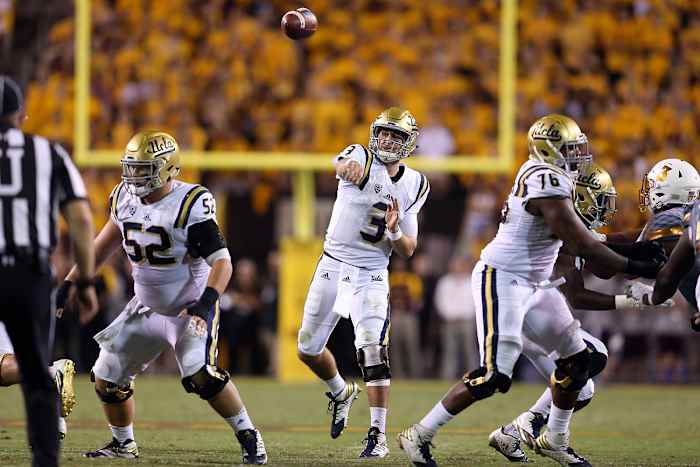
UCLA quarterback Josh Rosen could have an impact on the 2018 draft, if the rising junior declares early.
Chris Coduto/Icon Sportswire via Getty Images
1. Wait till next year? On my podcast the other day, my old buddy from NFL Network, Daniel Jeremiah, and I discussed a concept that I believe will come up plenty in the weeks to come: Some teams drafting high could wind up punting on the 2017 draft class of quarterbacks altogether with an eye towards 2018. The most pro-ready of the 2017 quarterbacks, Mitch Trubisky, had a grand total of 13 college starts. One college scouting director told me he believes Clemson’s Deshaun Watson is a year away from being ready to play, and Notre Dame’s DeShone Kizer is two years from that. And Cal’s Davis Webb and Texas Tech’s Patrick Mahomes come from an Air Raid style of offense that has made the NFL transition complicated for others (see: Jared Goff, Robert Griffin).
On the flip side, UCLA’s Josh Rosen, USC’s Sam Darnold and Wyoming’s Josh Allen have flashed top-of-the-draft potential, and all of them come from pro-style offenses and will have multiple years as starters under their belts in the spring of 2018. And on paper, it makes sense, and there will be teams that will determine there’s not a franchise guy in this year’s group, and that there will probably be more than one next year. Yup. Sounds great.
But the guys I talked to emphasized the risk in that sort of approach. “Sure, if you have job security and your owner is on board,” said an AFC exec. “You better make sure what you’re waiting for is worth it, though. This time last year, everyone would’ve said ‘Tank for Watson.’ Now, not so much. So you gotta make sure what you’re passing up isn’t gonna bite you in the ass. No one would’ve said ‘Tank for (Carson) Wentz’ a year ahead of time. Nobody even knew about the North Carolina kid last year. … If you find Andrew Luck in college football, yes, tank for him. But you better make sure you get him. It’d suck to be Washington and get the second guy.” The Redskins, you’ll remember passed on QBs in 2010 and ’11, then were one pick shy of Luck in ’12, winding up with Robert Griffin instead. (They did OK in the fourth round that year). “I’d say no on Rosen (there are off-field questions, in addition to a nerve issue he fought last year),” said the college scouting director who called Kizer and Watson projects. “Darnold, I like a lot, but needs to repeat that this year. He wasn’t good enough to start the season at USC—Why? And Josh (Allen) needs to make a lot of strides to be considered a top guy. He’s talented, but not accurate.”
Bottom line: Waiting is a dice roll, albeit one that could pay off big, and there aren’t many decision-makers who have the kind of job security to go through with it. That said, all those guys also are aware that getting it wrong in a pothole-ridden year for QBs like this one is just another route to the unemployment line.
2. The Ravens’ addition of Greg Roman should have an impact—right where you think it will.This week, new Ravens senior assistant Greg Roman told the team’s web site that it’d be a mistake to “pigeon hole” his hire as a move by head coach John Harbaugh to try and become more of a “ground and pound” offense. But my sense is that’s certainly a part of it.
Last year, Harbaugh fired offensive coordinator Marc Trestman because of his tendency to abandon the run late in games. In the first half of Trestman’s final game, Baltimore ran the ball 13 times for 74 yards and the Ravens went into the break controlling play and up 10-6. In the second half, Baltimore ran the ball just six times, and the Redskins came back to win. And the Ravens did run the ball more effectively after that, with Marty Morhinweg in command, but they still lacked consistency in that area. Trestman got the job in 2015 after promising he’d build on what Gary Kubiak established in 2014, when the Ravens ranked eighth in rush offense and ran the ball 448 times. Instead, the Ravens plummeted to 26th and 28th in rush offense in 2015 and ’16, and ran the ball just 328 and 343 times in those seasons, respectively.
As much as anything, bringing in Roman is a chance to reestablish the identity the offense had in Harbaugh’s first five years (they ranked top half of the league in rush offense in each of those seasons, top 10 three times, and top five twice.) In Roman’s four years working under Harbaugh’s brother Jim in San Francisco, the Niners ranked eighth, fourth, third and fourth in rush offense, and his 2015 Bills offense led the league in that category. It’s no mistake that Roman’s reputation is as one of the sport’s top run-game designers. The challenge in Baltimore will be different. He had more mobile quarterbacks in San Francisco and Buffalo. But hiring him should make the kind of difference the Ravens are expecting in pairing him with Morhinweg.
3. The Redskins’ dilemma on Kirk Cousins. Washington has two weeks to decide whether or not to hit Kirk Cousins with the franchise tag. And there’s been internal resistance to the idea of a second tag going back to when the Skins put the first tag on him last March. The reason why is simple. With the one-year price set at $23.95 million, the team’s ability to get a long-term deal would be seriously hamstrung, mostly because there’d be little motivation for the player (based on that number) to do a deal that’s even slightly short of the top of the quarterback market. Last year, the Redskins weren’t willing to go north of $16 million per year, and let Cousins play the year out at $19.958 million as a result. And since the season has ended, when Cousins became eligible again to do a long-term deal, the divide between the sides hasn’t really been bridged much.
As I understand it, the Redskins were of a mind to let the market decide what Cousins is worth, but I’d say that consideration has been seriously complicated over the past few weeks with the Rams hiring Sean McVay and the 49ers hiring Kyle Shanahan. Those two coaches, of course, are the only two offensive coordinators that Cousins has played for during his five-year career. If the Redskins let Cousins go to the market in early March, the Niners would sit at the top of the list of his suitors. The potential for the Rams to make a move on Cousins isn’t as immediate. But if things didn’t wind up working out with Jared Goff in 2017, it’s not insane to think the Rams might kick the tires on Cousins in 2018. So now, Cousins has Shanahan sitting out there to motivate the Redskins to tag him, and McVay behind Door 2 as a reason for them to do a long-term deal now based off that tag, rather than wait until 2018, when it’d cost $28.7 million to transition tag him and $35.91 million to franchise him.
Not a bad spot to be in, if you’re Cousins. His two-year take, if he’s tagged again, would be almost $44 million. And based off the two-tag principle many agents use with tagged players, it’s not crazy to think he’ll ask for close to $60 million in the first two years of a long-term deal.
4. Vikings have it all going to rebound. Except that …In the days following last year’s trade for Sam Bradford, I asked Vikings GM Rick Spielman if the move should resonate in the locker room and with the coaching staff as one signal that the team was in a championship window. “That would be fair, because of the way we’ve been building it the last three years,” Spielman answered. “(Mike Zimmer is) in his third year, and the team’s been steadily improving. You got guys moving into the prime of their careers, and some guys towards the tail end. We’ve worked so hard to upgrade from last year, winning the division, getting into the playoffs. We’ve improved the offensive line, adding another draft class. We’re in a situation where the team has an opportunity to have a really good year. I’m not sure you’d do this if it’s the first year in a program. … Everyone is really excited, and they know that in the situation we were dealt, I’ll never stand idle and say, ‘It is what it is.’”
That was before the Vikings lost both their tackles, and Adrian Peterson, and finished 8-8 as a result. But it’s fair to say they go into this offseason in a spot not that dissimilar to the aftermath of the Teddy Bridgewater injury—with a very solid roster that has one significant hole. And that hole isn’t at quarterback or even running back, should they move on from Peterson. It’s along the offensive line.
My feeling is they try and hold on to left tackle Matt Kalil, whose had a disappointing five-year start to his career and spent most of last year on IR. But guard Brandon Fusco was just released, and right tackle Andre Smith and center Joe Berger, like Kalil, are free agents. The draft class isn’t exactly flush with linemen, either. Now, there are good free agents out there, and guys like Cincinnati’s Kevin Zeitler or Andrew Whitworth who make a lot of sense because of their background with Zimmer. But this seems like it may take more of overhaul than a tweak or two, and that’s why I believe it’s one of the more overlooked offseason storylines out there, particularly because the team sees itself in that aforementioned window of opportunity.
* * *
OFFSEASON LESSON TO LEAVE WITH YOU

Pittsburgh’s Le’Veon Bell is a candidate for the franchise tag, which could top $12 million for running backs.
Mark Alberti/Icon Sportswire via Getty Images
In the first two years of the current collective bargaining agreement, 32 prospective free agents were slapped with the franchise tag by their teams. It was a result, in part, of a recalculation that drove down the numbers.
The union swore back then that the effect would be temporary. The union was right.
So with the franchise tag period set to open Wednesday, our lesson for this week will relate to how you should view your team placing it on a player. It’s abundantly clear, too. The franchise tag isn’t what it used to be.
Owners insisted on changing the formula in 2011, because teams dumping cap money into the uncapped year of 2010 had created an affect on the numbers, which were then based on the average of the top-five salaries at each position. The new formula would be based on five-year averages, plus a percentage of the cap, and that they came out low early gave teams a green light to use the tag in a different way.
For the elite, the lower tag numbers were employed as a leverage point in long-term negotiations. For the less-than-elite, its function was often to hold a player for a year while the team sorted out its situation at the player’s position.
Among the players tagged in 2011 and ’12: Paul Soliai, Kamerion Wimberly, Marcedes Lewis, Fred Davis, Tyvon Branch and six kickers. All due respect to those guys, it’s fair to say they aren’t the types that owners had in mind at the creation of the tag, which was actually motivated in part by Broncos owner Pat Bowlen’s fear that he could lose John Elway.
A half-decade later, the tag isn’t used that way anymore.
In fact, in the majority of cases now, the high prices on tags mean the players need to be so good that there’s little question the teams would want to do long-term deals. Eight of the 14 players tagged the past two years wound up getting multi-year deals, another got his tag rescinded (Josh Norman) because the sides couldn’t reach one, and others (Eric Berry, Kirk Cousins) simply chose to stay on the one-year tender.
“I would say the money is high enough now, where the tag is good for players not because of the first-year money alone, but also the second year,” said one prominent agent. “In that way, the franchise-tag is your friend, because the tags over two years give you context for a long-term deal.”
Another agent added, “What’s good about it is that it helps (players) gauge their market. I hate the device, and I think it’s a massive loss for them in collective bargaining. But the teams that use it now know that the guy you’re tagging needs to be a key piece in the machine.”
We won’t have the official numbers until after the cap is set (likely at the combine), but it’s a certainty that tag figures at quarterback, receiver, offensive line, defensive end, linebacker, and cornerback will exceed $14 million, and the defensive tackle number will come in just under that. There are 42 players in the NFL now on deals worth $14 million per year or more, and 22 of them are quarterbacks.
Based on that? Players certainly don’t have reason to dread the tag like they once did.
• Question or comment? Email us at talkback@themmqb.com
































